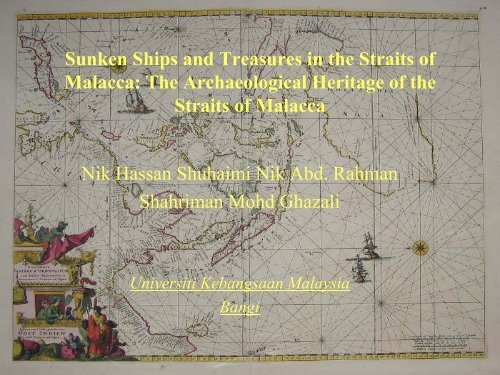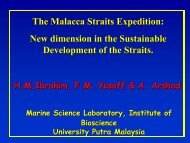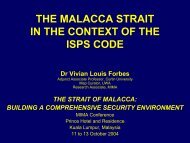The Archaeological Heritage of the Straits of Malacca Nik Hassan ...
The Archaeological Heritage of the Straits of Malacca Nik Hassan ...
The Archaeological Heritage of the Straits of Malacca Nik Hassan ...
You also want an ePaper? Increase the reach of your titles
YUMPU automatically turns print PDFs into web optimized ePapers that Google loves.
Sunken Ships and Treasures in <strong>the</strong> <strong>Straits</strong> <strong>of</strong><br />
<strong>Malacca</strong>: <strong>The</strong> <strong>Archaeological</strong> <strong>Heritage</strong> <strong>of</strong> <strong>the</strong><br />
<strong>Straits</strong> <strong>of</strong> <strong>Malacca</strong><br />
<strong>Nik</strong> <strong>Hassan</strong> Shuhaimi <strong>Nik</strong> Abd. Rahman<br />
Shahriman Mohd Ghazali<br />
Universiti Kebangsaan Malaysia<br />
Bangi
Introduction<br />
• <strong>The</strong> region was a large single landmass until <strong>the</strong> late<br />
Pleistocein (circa 10,000 years BP)<br />
• Present <strong>Malacca</strong> strait took shape around 5000 years BP<br />
• Settlements emerge along <strong>the</strong> coast followed by shipping<br />
from around 2500 years BP.<br />
• Cultural heritage means <strong>the</strong> natural and physical<br />
resources that contribute to an understanding and<br />
appreciation <strong>of</strong> our nation’s history, culture and national<br />
identity.
Land Remains and Place names<br />
• Numerous references and description from ancient text<br />
including <strong>the</strong> Greeks, Arabs, Hindu and Buddhist literature<br />
on settlements, trading centres and polities in this region.<br />
• ie; Takola, Kidaram, Tun-sun, Fo-lo-an, Kalah, Lang-yashia,<br />
takuapa, Mo-lo-yu and etc<br />
• Some place names complimented by archaeological<br />
researches and finds prehistoric harbours Klang, Morib,<br />
Muar<br />
• Material cultures; Bronze drums, socketed tools (500BC)<br />
• Dongson material cultures <strong>of</strong> Vietnam<br />
• Bujang Valley (5 th century AD) settlement @ harbours
Maritime Cultural Landscape <strong>of</strong> <strong>the</strong><br />
<strong>Malacca</strong> Strait<br />
• MCL comprises <strong>the</strong> whole network <strong>of</strong> sailing routes, old as<br />
well as new, with portsand harbours along <strong>the</strong> coast and<br />
it’s related construction and remains <strong>of</strong> human activity,<br />
underwater as well as terestrial.<br />
• MCL displays a chronological stratification pattern with<br />
each layer (containing material culture and environmental<br />
elements) been shaped and transformed by human activity.<br />
• To Archaeologists very important<br />
• To treasure hunters what MCL?? $£RM$£?
Three types <strong>of</strong> <strong>Malacca</strong> <strong>Straits</strong> MCL resources<br />
1. Shipwrecks - types, building tradition, technology,<br />
navigation, cargo (trade, personal, provision,<br />
operation), armament, social structure and etc.<br />
2. Land remains and Place names<br />
- maritime structures, monument, material culture, place<br />
names from literature and ethnology.<br />
3. <strong>The</strong> Environment and Site Formation Processes (SFP)<br />
-Understanding <strong>the</strong> relationship between artefact<br />
assemblages and environment. Sort <strong>of</strong> quality control in<br />
archaeology.
Material Remains: Shipwrecks; types &<br />
archaeology<br />
• Earliest water transport in <strong>the</strong> SOM were dugouts or<br />
dugout based boats probably circa 500 B.C.<br />
• Boat shape show similarity throughout <strong>the</strong> world during<br />
this time ie: dugout base, stitching, overlapping planks and<br />
use <strong>of</strong> sail.<br />
• “Hugging <strong>the</strong> coast” type <strong>of</strong> sea voyage Dongson<br />
material culture <strong>of</strong> Annam<br />
• Commercial trade via <strong>the</strong> SOM began late 4 th century A.D.
<strong>The</strong> Dhows and Islam in S.E.A<br />
• Indian, Arab and Persian ships – Boom, Baghla, zarouk,<br />
sambuk, bedan and etc<br />
• Among <strong>the</strong> earliest to use <strong>the</strong> S.O.M circa early 5 th<br />
century AD – Chinese trade<br />
• Boom - older and more traditional<br />
- teak and palm wood built, double ended, lashed and<br />
sewn planking, lateen sail, single deck, tiller rudder<br />
• Baghla – 17 th century plus European influenced design<br />
- transom stern, l<strong>of</strong>ty decorated poop, big rudder in<br />
rudder trunk.
Dhows and Islam in S.E.A<br />
• <strong>Archaeological</strong> records <strong>of</strong> early dhows in this region are<br />
extremely scarce. A rare example is <strong>the</strong> Belitung wreck<br />
• <strong>Archaeological</strong> evidence is crucial for <strong>the</strong> understanding <strong>of</strong><br />
<strong>the</strong> heritage <strong>of</strong> <strong>the</strong> Malays and o<strong>the</strong>r Muslim race in <strong>the</strong><br />
region.<br />
• Knowledge about <strong>the</strong> muslim seafaring culture, practice,<br />
navigation, practice <strong>of</strong> Islam on board ships and<br />
shipbuilding technology.
A Baghla ( Goldsmith, 1969)<br />
A Boom (Green, 1996)
An artist impression <strong>of</strong> <strong>Malacca</strong> in <strong>the</strong><br />
15 th century<br />
An muslim seaman performing<br />
solat on board a dhow
Junks and <strong>the</strong> ceramics trade<br />
• Junks had been in <strong>the</strong> SOM since <strong>the</strong> 9th century AD.<br />
• General name for <strong>the</strong> type <strong>of</strong> ship belonging to <strong>the</strong> far east<br />
from China to South East Asian states.<br />
• 3 potential junk types based on built and fastening design<br />
sailed <strong>the</strong> SOM namely <strong>the</strong>;<br />
• Tradisional Chinese junk (Quanzhou ship type) – Keeled<br />
V-shaped hull, iron fasteners<br />
• South East Asian type- (S.E.Asian ships)- tropical<br />
hardwood, wooden dowels, keelless flat bottomed<br />
• South China Sea type – (hybrid Chinese design built in<br />
S.E.A shipyard)- hardwood built, dowels and iron nails.
Quanzhou ship<br />
wreck site 1970’s<br />
Reconstruction <strong>of</strong> <strong>the</strong><br />
Quanzhou ship, a traditional<br />
Chinese sea-going junk.
Artists impression <strong>of</strong> various o<strong>the</strong>r junks including<br />
<strong>the</strong> S.C. Sea and S.E. Asian junks
A drawing <strong>of</strong> Chinese junks engaged in a sea fight
Junks and <strong>the</strong> ceramics trade<br />
• <strong>The</strong>y were dominant seafaring power during <strong>the</strong> 14th and<br />
early 15th century – many were wrecked especially in<br />
South China Sea and most probably so in <strong>the</strong> SOM.<br />
• Commonly associated with <strong>the</strong> oriental ceramics trade<br />
hence popular treasure hunters bounty.<br />
• <strong>The</strong> sole recovery <strong>of</strong> <strong>the</strong> ceramics undermine <strong>the</strong><br />
importance and existence <strong>of</strong> o<strong>the</strong>r material culture and it’s<br />
assemblages.<br />
• Treasure hunting have a negative effect on <strong>the</strong> heritage as<br />
far as archaeology and heritage conservation are<br />
concerned.
Some wreck names and finds belonging to <strong>the</strong> junk group reported in South East Asia<br />
(source Green, 1996; Brown & Sjostrand 2002; URL: maritime-explorations.com)<br />
Wreck/ Site Location lost /(found Brief comment<br />
Ko Si Chang 1 Gulf <strong>of</strong> 1573-1620 Thai junk (S.E.Asian type?)<br />
Thailand (1983) archaeologically excavated and published<br />
Ko Si Chang 3 Gulf <strong>of</strong> 1405-1433 Thai junk (S.E.Asian type?)<br />
Thailand (1985) archaeologically excavated and published<br />
Turiang S. C. Sea 1370’s Chinese junk (Quanzhou type) Salvaged<br />
Malaysia (1998) for ceramics<br />
Pattaya Gulf <strong>of</strong> 16<br />
Thailand<br />
th century Quanzhou type junk; archaeologically<br />
(1980) excavated and published<br />
Nanyang S.C. Sea 1380’s S.C. Sea type junk; salvaged for ceramics<br />
Malaysia (1990’s)<br />
Bakau Karimata St. 15<br />
Indonesia<br />
th century Chinese junk; archaeologically surveyed<br />
(1999) and published<br />
Brunei S.C. Sea Late 15<br />
Brunei<br />
th cty Chinese junk (Quanzhou type?); surveyed<br />
(1998) and excavated<br />
Longquan S.C. Sea 1400’s S.C. Sea type junk; salvaged for ceramics<br />
Malaysia (1996)<br />
Royal Nanhai S.C. Sea mid 15<br />
Malaysia<br />
th cty S.C.Sea type junk; excavated and salvaged<br />
(1998) for ceramics<br />
Binh Thuanh Vietnam 1608<br />
(2002)<br />
Chinese junk; surveyed and excavated<br />
Xuande S.C.Sea 1540’s No wreck??; salvaged for ceramics<br />
Malaysia (1996)<br />
Singtai S.C. Sea 1550’s S.C. Sea type; surveyed and sampling <strong>of</strong><br />
Malaysia (2001) ceramics<br />
Desaru S.C.Sea 1830’s Chinese junk; salvaged for ceramics<br />
Malaysia (2001)<br />
Vung Tau South 1690’s Chinese lorcha; surveyed and excavated<br />
Vietnam (1991)
Carracks, Galleons and East Indiamen<br />
• <strong>The</strong> Portuguese pioneered <strong>the</strong> Europeans quests for <strong>the</strong><br />
riches <strong>of</strong> <strong>the</strong> east in <strong>the</strong> early 16 th century on board <strong>the</strong><br />
Carracks or Naos<br />
• <strong>The</strong>se ships played an important role in <strong>the</strong> Portuguese<br />
conquest and <strong>the</strong> fall <strong>of</strong> <strong>the</strong> Malay Sultanates.<br />
• Many ships might had sunk during <strong>the</strong> subsequent conflicts<br />
within <strong>the</strong> region .<br />
• example Flor De La Mar.
Impressions <strong>of</strong> Portuguese Carracks (NMM)
Portuguese Carracks and galleys <strong>of</strong>f a Mediteranean Coast (NMM)
Carracks, Galleons and East Indiamen<br />
• <strong>The</strong> Dutch came next with <strong>the</strong> early generation <strong>of</strong> <strong>the</strong><br />
smaller but much efficient galleons.<br />
• <strong>The</strong> major design differences include <strong>the</strong> slender and lower<br />
built hull, <strong>the</strong> disappearance <strong>of</strong> <strong>the</strong> towering fore and<br />
sterncastle, ordinance arrangements on decks and etc.<br />
• <strong>The</strong> Battle <strong>of</strong> Cape Rachado 1606 saw many European<br />
ships wrecked at Bambek shoal.<br />
• Risdam (1726) was a rare well preserved wreck <strong>of</strong> a VOC<br />
fluit
Reproduction <strong>of</strong> <strong>the</strong> Drawing <strong>of</strong> <strong>The</strong> Battle <strong>of</strong> Cape Rachado (Bound,1996)
Illustration <strong>of</strong> <strong>the</strong> Nassau<br />
excavation (Bound, 1996)
A dutch soldier c. 1607<br />
Drawing <strong>of</strong> a Dutch warship similar to Nassau
Carracks, galleons and East Indiamen<br />
• British East India Company ships were dominant in <strong>the</strong><br />
late 18 th century and through to <strong>the</strong> 19 th century<br />
• <strong>The</strong> Diana (c.1817) wrecked <strong>of</strong> Tg. Bidara and salvaged in<br />
1994<br />
• <strong>The</strong> Caroline, ano<strong>the</strong>r country ship wrecked at Bambek<br />
shoal
A British East India Company country ship similar to <strong>the</strong> Diana and Caroline
Some European wreck names reported from <strong>the</strong> <strong>Malacca</strong> <strong>Straits</strong> (source: Bound, 1996;<br />
Brown & Sjostrand, 2002)<br />
Wreck/ Site lost/ (found) Location Brief comment<br />
Nassau 1606<br />
(1993)<br />
Diana 1817<br />
(1993)<br />
Middleburg 1606<br />
(1993)<br />
Sao Salvador 1606<br />
(1993)<br />
Dom Duarte’s 1606<br />
Galleon<br />
(1993)<br />
Caroline 1816<br />
(not found)<br />
Flor De La Mar<br />
Sao Simao<br />
1511<br />
(not found)<br />
Todos os Santos<br />
Erasmus<br />
Santa Cruz<br />
Nossa Senhora De<br />
Conceicao<br />
Santo Antonio<br />
Sao Nicolao<br />
1606?<br />
<strong>The</strong> battle<br />
before<br />
<strong>Malacca</strong> after<br />
battle <strong>of</strong> Cape<br />
Rachado<br />
Bambek<br />
Shoal<br />
Off Tanjung<br />
Bidara<br />
Bambek<br />
Shoal<br />
Bambek<br />
Shoal<br />
Bambek<br />
Shoal<br />
Bambek<br />
Shoal<br />
Nor<strong>the</strong>ast<br />
Sumatera<br />
<strong>Malacca</strong><br />
waters<br />
VOC warship; archaeologically excavated,<br />
published, recovered artifacts sent to<br />
National Museum.<br />
British East India Co. country ship;<br />
excavated mainly for Chinese ceramics<br />
cargo.<br />
VOC warship; location identified from<br />
historical and magnetometer survey<br />
Portuguese galleon; location identified<br />
from historical and magnetometer survey<br />
Portuguese galleon; location identified<br />
from historical and magnetometer survey<br />
British East India Company country ship<br />
Portuguese carrack?; <strong>the</strong> most popular yet<br />
elusive wreck despite intensive search<br />
A mixture <strong>of</strong> Portuguese carracks and<br />
galleons; based on historical accounts from<br />
<strong>the</strong> battle <strong>of</strong> Cape Rachado and <strong>the</strong> Battle<br />
before <strong>the</strong> fall <strong>of</strong> <strong>Malacca</strong> into Dutch<br />
hands.<br />
Many wrecks were ei<strong>the</strong>r destroyed by <strong>the</strong><br />
Dutch warships or self-destroyed by<br />
setting on fire to avoid falling into <strong>the</strong><br />
Dutch hands.
Early Traditional Malay vessel ( <strong>the</strong> Prahus)<br />
• Although numerous names for <strong>the</strong> prahus were mentioned<br />
in <strong>the</strong> Malay Annal, <strong>the</strong> archaeological evidence <strong>of</strong> early<br />
Malay vessels remain elusive.<br />
• Current knowledge on early Malay shipbuilding and<br />
seafaring traditions are based on literature resources <strong>of</strong><br />
foreign historical explorers and writers. innaccurate and<br />
debatable<br />
• <strong>Archaeological</strong> record are crucial for understanding <strong>the</strong><br />
true maritime heritage <strong>of</strong> <strong>the</strong> Malays
A Malay coastal trader<br />
A flying prahu/prau<br />
Impression <strong>of</strong> a Lanchara
Land remains and place names<br />
• As mentioned in <strong>the</strong> earlier part by Pr<strong>of</strong>. Dato’ <strong>Nik</strong> <strong>Hassan</strong>
Wreck / Site formation Processes<br />
• Study <strong>of</strong> <strong>the</strong> surrounding environmental processes that<br />
shaped an archaeological site<br />
• natural and anthropological influence<br />
• Identify filters and scramblers important in analysis <strong>of</strong><br />
artefact assemblages<br />
• Multidiciplinary involvement and participation.
site formation processes<br />
• <strong>Malacca</strong> <strong>Straits</strong> hydrodynamic environment<br />
• Biological , chemical and geological<br />
• Sand shoals and wrecks uncanny relationship<br />
• Human factor looting, sandmining, trawling,<br />
pollution, shipping, U/W construction
Legal Instrument & U/W heritage issues<br />
• <strong>The</strong> lure <strong>of</strong> treasure lead to various security and safety<br />
issues encroachment, stealing & conflicts <strong>of</strong> resources<br />
• Legal instrument important for protection and management<br />
• Antiquities Act 1976, Merchant Shipping Ordinance 1952,<br />
UNCLOS 1982.<br />
• Historical Shipwreck Act ????<br />
• UN Convention on <strong>the</strong> Protection <strong>of</strong> <strong>the</strong> Underwater<br />
Cultural <strong>Heritage</strong> 2001…….yes? no?
Conclusion<br />
• Knowledge about <strong>the</strong> heritage need to be studied first hand<br />
not only from foreign writings.<br />
• Ethnological and archaeological approach are crucial in <strong>the</strong><br />
understanding <strong>of</strong> our maritime legacy.<br />
• Quantity and more importantly quality resources are<br />
desired<br />
• Awareness in <strong>the</strong> community about <strong>the</strong> heritage and <strong>the</strong><br />
ever existing threat.
Thank You All




